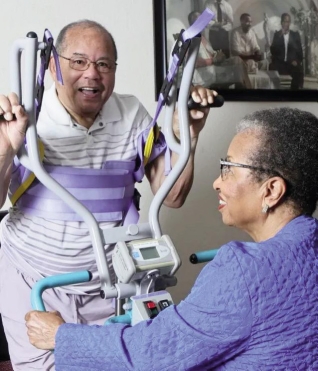suggested. And since people are sometimes reimbursed by family members for their assistance, being unpaid shouldn't be a requirement, suggested Anne Tumlinson, founder and chief executive officer of ATI Advisory, a consulting firm in aging and disability policy.
As for the frequency of training, a one-size-fits-all approach isn't appropriate given the varied needs of older adults and the varied skills of people who assist them, said Sharmila Sandhu, vice president of regulatory affairs at the American Occupational Therapy Association. Some caregivers may need a single session when a loved one is discharged from a hospital or a rehabilitation facility.

CONSTANT CARE: Cheryl Brown's husband, Hardy, was diagnosed with amyotrophic lateral sclerosis, also known as Lou Gehrig's disease, in 2002. He can't walk but he can use his arms and hands. Brown says she "never gets a break" from caregiving responsibilities.
Others may need ongoing training as conditions such as heart failure or dementia progress and new complications occur, said Kim Karr, who manages payment policy for AOTA.
When possible, training should be delivered in a person's home rather than at a health care institution, suggested Donna Benton, director of the University of Southern California's Family Caregiver Support Center and the Los Angeles Caregiver Resource Center. All too often, recommendations that caregivers get from health professionals aren't easy to implement at home and need to be adjusted, she noted.
Nancy Gross, 72, of Mendham, New Jersey, experienced this when her husband, Jim Kotcho, 77, received a stem cell transplant for leukemia in May 2015. Once Kotcho came home, Gross was responsible for flushing the port that had been implanted in his chest, administering medications through that site, and making sure all the equipment she was using was sterile.
Although a visiting nurse came out and offered education, it wasn't adequate for the challenges Gross confronted. "I'm not prone to crying, but when you think your loved one's life is in your hands and you don't know what to do, that's unbelievably stressful," she told me.
For her part, Cheryl Brown, 79, of San Bernardino, California – a caregiver for her husband, Hardy Brown Sr., 80, since he was diagnosed with ALS in 2002 – is skeptical about paying professionals for training. At the time of his diagnosis, doctors gave Hardy five years, at most, to live. But he didn't accept that prognosis and ended up defying expectations.
Today, Hardy's mind is fully intact, and he can move his hands and his arms but not the rest of his body. Looking after him is a fulltime job for Cheryl, who is also chair of the executive committee of California's Commission on Aging and a former member of the California State Assembly. She said hiring paid help isn't an option, given the expense.
And that's what irritates Cheryl about Medicare's training proposal. "What I need is someone who can come into my home and help me," she told me. "I don't see how someone like me, who's been doing this a very long time, would benefit from this. We caregivers do all the work, and the professionals get the money? That makes no sense to me."
ABOUT THE AUTHOR:
Judith Graham, a contributing columnist, writes the "Navigating Aging" column for KFF Health News. She has covered health care for more than 30 years. She's been an investigative reporter, national correspondent and senior health reporter at the Chicago Tribune and a regular contributor to The New York Times' New Old Age blog. Judith was the first topic leader on aging for the Association of Health Care Journalists. Her work has appeared in publications including Stat News, The Washington Post, and the Journal of the American Medical Association. She is a graduate of Harvard College and has a master's in journalism from Columbia University.
